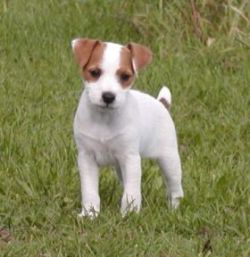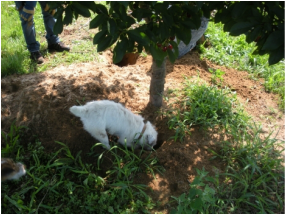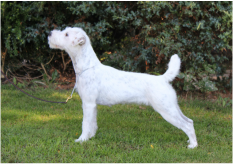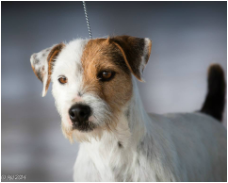FAQ
History of the Jack Russell Terrier

History of the Jack Russell TerrierJack Russell Terriers are a type, or strain, of working terrier; they are not pure bred in the sense that they have a broad genetic make-up, a broad standard, and do not breed true to type. This is a result of having been bred strictly for hunting since their beginning in the early 1800's, and their preservation as a working breed since. The broad standard, varied genetic background based on years of restricted inbreeding and wide outcrossing, and great variety of size and type, are the major characteristics that make this strain of terrier known as a Jack Russell (a.k.a. Parson Jack Russell Terrier®) such a unique, versatile working terrier.
The Jack Russell Terrier takes it name from the Reverend John Russell who bred one of the finest strains of terriers for working fox in Devonshire, England in the mid-to-late 1800's. Rev. Russell (1795-1883), apart from his church activities, had a passion for fox hunting and the breeding of fox hunting dogs; he is also said to be a rather flamboyant character, probably accounting for his strain of terrier's notability and the name of our terrier today. His first terrier, the immortal TRUMP, is said to be the foundation of John Russell's strain of working terriers.
Everything about the Jack Russell has fox hunting in mind .... coloring, conformation, character, and intelligence. The body is compact, of totally balanced proportions, the shoulders clean, the legs straight, and most importantly, a small chest (easily spannable by average size hands at the widest part behind the shoulders). The Jack Russell must also be totally flexible, allowing him to maneuver underground. This conformation allows the terrier to follow his quarry down narrow earths. The fox is a good model for the Jack Russell-where the fox can go, so must the terrier. Although originally bred for fox hunting, the Jack Russell is a versatile working terrier to a variety of quarry including red and grey fox, raccoon and woodchuck.
John Russell maintained his strain of fox terriers bred strictly for working, and the terrier we know of today as the Jack Russell is much the same as the pre-1900 fox terrier. The Jack Russell has survived the changes that have occurred in the modern-day Fox Terrier because it has been preserved by working terrier enthusiasts in England for more than 100 years; it has survived on its merits as a worker. It is the foremost goal of the JRTCA that the Jack Russell continues in that tradition. This is been copied from the JRTCA Web site
The Jack Russell Terrier takes it name from the Reverend John Russell who bred one of the finest strains of terriers for working fox in Devonshire, England in the mid-to-late 1800's. Rev. Russell (1795-1883), apart from his church activities, had a passion for fox hunting and the breeding of fox hunting dogs; he is also said to be a rather flamboyant character, probably accounting for his strain of terrier's notability and the name of our terrier today. His first terrier, the immortal TRUMP, is said to be the foundation of John Russell's strain of working terriers.
Everything about the Jack Russell has fox hunting in mind .... coloring, conformation, character, and intelligence. The body is compact, of totally balanced proportions, the shoulders clean, the legs straight, and most importantly, a small chest (easily spannable by average size hands at the widest part behind the shoulders). The Jack Russell must also be totally flexible, allowing him to maneuver underground. This conformation allows the terrier to follow his quarry down narrow earths. The fox is a good model for the Jack Russell-where the fox can go, so must the terrier. Although originally bred for fox hunting, the Jack Russell is a versatile working terrier to a variety of quarry including red and grey fox, raccoon and woodchuck.
John Russell maintained his strain of fox terriers bred strictly for working, and the terrier we know of today as the Jack Russell is much the same as the pre-1900 fox terrier. The Jack Russell has survived the changes that have occurred in the modern-day Fox Terrier because it has been preserved by working terrier enthusiasts in England for more than 100 years; it has survived on its merits as a worker. It is the foremost goal of the JRTCA that the Jack Russell continues in that tradition. This is been copied from the JRTCA Web site
Is A Jack Russell Terrier the Right Breed for me?

The Jack Russell Terrier is not the dog for everyone. As you would have read in the history section, the Jack Russell is a hunting dog with strong hunting instincts still to this day. They will keep your yard clear of anything that moves on four feet, including cats and other vermin's. The Jack Russell needs to have a fully fenced in yard, an apartment or condo will not do. They need lots of exercise and will remain active until the very end. Jack Russell's do better in a home where they are given a job to do, so proper training is a must, agility, fly ball and disc are some of the fun activities you can do with your Jack Russell. Please do your research when looking into this breed.
Breed Standard

General Appearance
A sturdy, tough terrier, very much on its toes all the time, measuring between 10" and 15" at the withers. The body length must be in proportion to the height, and it should present a compact, balanced image, always being in solid, hard condition.
Characteristics
The terrier must present a lively, active and alert appearance. It should impress with its fearless and happy disposition. It should be remembered that the Jack Russell is a working terrier and should retain these instincts. Nervousness, cowardice or over-aggressiveness should be discouraged and it should always appear confident.
A sturdy, tough terrier, very much on its toes all the time, measuring between 10" and 15" at the withers. The body length must be in proportion to the height, and it should present a compact, balanced image, always being in solid, hard condition.
Characteristics
The terrier must present a lively, active and alert appearance. It should impress with its fearless and happy disposition. It should be remembered that the Jack Russell is a working terrier and should retain these instincts. Nervousness, cowardice or over-aggressiveness should be discouraged and it should always appear confident.

Head
Should be well balanced and in proportion to the body. The skull should be flat, of moderate width at the ears, narrowing to the eyes. There should be a defined stop but not overpronounced. The length of the muzzle from the nose to the stop should be slightly shorter than the distance from the stop to the occiput. The nose should be black. The jaw should be powerful and well boned with strongly muscled cheeks.
Eyes
Should be almond shaped, dark in color and full of life and intelligence.
Ears
Small "V" shaped drop ears carried forward close to the head and of moderate thickness.
Mouth
Strong teeth with the top slightly overlapping the lower. The left two bites are acceptable; the far left bite is preferred.
Neck
Clean and muscular, of good length, gradually widening at the shoulders.
Forequarters
The shoulders should be sloping and well laid back, fine at points and clearly cut at the withers. Forelegs should be strong and straight boned with joints in correct alignment. Elbows hanging perpendicular to the body and working free of the sides.
Body
The chest should be shallow, narrow and the front legs not too widely apart, giving an athletic, rather than heavily chested appearance. As a guide only, the chest should be small enough to be easily spanned behind the shoulders, by average sized hands, when the terrier is in a fit, working condition. The back should be strong, straight and, in comparison to the height of the terrier, give a balanced image. The loin should be slightly arched.
Hindquarters
Should be strong and muscular, well put together with good angulation and bend of stifle, giving plenty of drive and propulsion. Looking from behind, the hocks must be straight.
Feet
Round, hard padded, wide, of cat-like appearance, neither turning in nor out.
Tail
Should be set rather high, carried gaily and in proportion to body length, usually about four inches long, providing a good hand-hold.
Coat
Smooth, without being so sparse as not to provide a certain amount of protection from the elements and undergrowth. Rough or broken coated, without being woolly.
Color
White should predominate (i.e., must be more than 51% white) with tan, black, or brown markings. Brindle markings are unacceptable.
Gait
Movement should be free, lively, well coordinated with straight action in front and behind.
Special Notes
Old scars or injuries, the result of work or accident, should not be allowed to prejudice a terrier's chance in the show ring unless they interfere with its movement or with its utility for work or stud.A Jack Russell Terrier should not show any strong characteristics of another breed.
Faults
Shyness, Disinterest, Overly aggressive, Defects in bite, Weak jaws, Fleshy ears, Down at the shoulder, Barrel ribs, Out at elbow, Narrow hips, Straight stifles, Weak feet, Sluggish or unsound movement, Dishing, Plaiting, Toeing, Silky or woolly coats, Too much color (less than 51% white), Shrill or weak voice, Lack of muscle or skin tone, Lack of stamina or lung reserve, Evidence of foreign blood
Should be well balanced and in proportion to the body. The skull should be flat, of moderate width at the ears, narrowing to the eyes. There should be a defined stop but not overpronounced. The length of the muzzle from the nose to the stop should be slightly shorter than the distance from the stop to the occiput. The nose should be black. The jaw should be powerful and well boned with strongly muscled cheeks.
Eyes
Should be almond shaped, dark in color and full of life and intelligence.
Ears
Small "V" shaped drop ears carried forward close to the head and of moderate thickness.
Mouth
Strong teeth with the top slightly overlapping the lower. The left two bites are acceptable; the far left bite is preferred.
Neck
Clean and muscular, of good length, gradually widening at the shoulders.
Forequarters
The shoulders should be sloping and well laid back, fine at points and clearly cut at the withers. Forelegs should be strong and straight boned with joints in correct alignment. Elbows hanging perpendicular to the body and working free of the sides.
Body
The chest should be shallow, narrow and the front legs not too widely apart, giving an athletic, rather than heavily chested appearance. As a guide only, the chest should be small enough to be easily spanned behind the shoulders, by average sized hands, when the terrier is in a fit, working condition. The back should be strong, straight and, in comparison to the height of the terrier, give a balanced image. The loin should be slightly arched.
Hindquarters
Should be strong and muscular, well put together with good angulation and bend of stifle, giving plenty of drive and propulsion. Looking from behind, the hocks must be straight.
Feet
Round, hard padded, wide, of cat-like appearance, neither turning in nor out.
Tail
Should be set rather high, carried gaily and in proportion to body length, usually about four inches long, providing a good hand-hold.
Coat
Smooth, without being so sparse as not to provide a certain amount of protection from the elements and undergrowth. Rough or broken coated, without being woolly.
Color
White should predominate (i.e., must be more than 51% white) with tan, black, or brown markings. Brindle markings are unacceptable.
Gait
Movement should be free, lively, well coordinated with straight action in front and behind.
Special Notes
Old scars or injuries, the result of work or accident, should not be allowed to prejudice a terrier's chance in the show ring unless they interfere with its movement or with its utility for work or stud.A Jack Russell Terrier should not show any strong characteristics of another breed.
Faults
Shyness, Disinterest, Overly aggressive, Defects in bite, Weak jaws, Fleshy ears, Down at the shoulder, Barrel ribs, Out at elbow, Narrow hips, Straight stifles, Weak feet, Sluggish or unsound movement, Dishing, Plaiting, Toeing, Silky or woolly coats, Too much color (less than 51% white), Shrill or weak voice, Lack of muscle or skin tone, Lack of stamina or lung reserve, Evidence of foreign blood